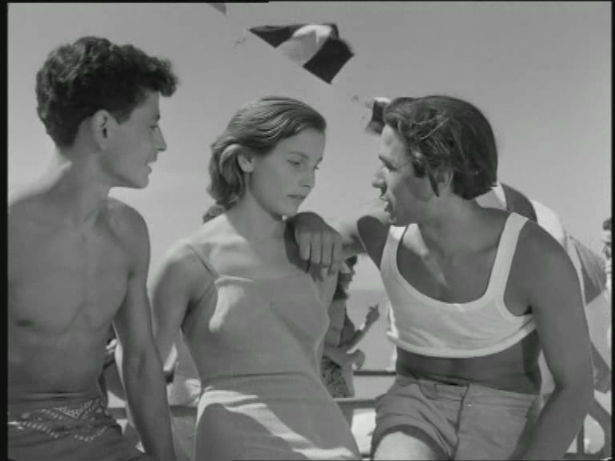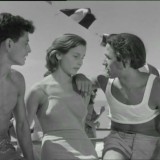It’s August in Rome and it seems like the whole town has a single mission – go to the beach! You can watch this charming, time-capsule of a movie below (76 minutes, no English subtitles, though).
[youtube width=”615″ height=”346″]http://www.youtube.com/watch?v=Uf1mTyF32v8&feature=share&list=PLU7L0O6PxEi14wMOExIx5mlUiW0ssEQIn[/youtube] Full film
In this light comedy, categorized under “Pink Neorealism,” precursor to later Italian comedy genre (considering that just a year earlier in 1948 Vittorio di Sica released the emblematic Neorealistic film Bicycle Thieves featuring real existential needs!) – director Luciano Emmer provides a much lighter view of post-WWII Italian society.
The plot leverages what I call “channel-zapping” storytelling technique, where four distinct stories are switched back and forth: the cyclists, the big common family, the rich folks and the humble couple. Four stories for which apparently only two are connected, vividly paint a lively, and quiet authentic picture of summer pastime habits of Romans in the late 1940’s.
 Young Anna Baldini approached by the local boys to join the dance (see hand tactic)
Young Anna Baldini approached by the local boys to join the dance (see hand tactic)
The film was shot in Rome specifically Porta Cavalleggeri, park of Colle Oppio, the Testaccio, Mattatoio and the Aostia train stations and beach. What strikes me the most is the consistent element of crowds everywhere, with people pushing and pulling their way on roads, train station, entrance to the beach and finally when settled down on the beach. And as such I couldn’t help thinking of those classic Coney Island crowded beach pictures or the crowded pool scene in Boccaccio ’70: Renzo e Luciana (Mario Monicelli – 1962).
The film boasts a wide range of actors early in their career, some I recognized from other memorable films like Mario Vitale who played the tough husband of Ingrid Bergman in Stromboli – Stromboli, Terra di Dio (Roberto Rossellini – 1950), young Franco Interlenghi from Sciuscià – Shoeshine (Vittorio De Sica – 1946), Massimo Serato that married Anna Mgnani for a few years and played in La signora delle camelie (Carmine Gallone – 1947), Emilio Cigoli that in this film plays somewhat similar role to his earlier role in I bambini ci guardano – The Children are Watchin Us – (Vittorio De Sica – 1944), and Marcello Mastroianni that needs no introduction, which in this film was dubbed by no one else but Alberto Sordi. There were also a few cinematic debuts for Elvy Lissiak that kicked off her long career, Anna di Leo casted as Jolanda, friend of Marcella played by another first for Anna Baldini, who was only 15 when shooting this film.
 The cyclists group getting ready to kickoff the ride to the beach
The cyclists group getting ready to kickoff the ride to the beach
It’s interesting to see how the quest for some fresh air on the beach unites all characters regardless of their social class, age and gender. Each one uses their own means of transportation (e.g., bicycles, over-crowded clunky car, sports car, and train) to reach the beach. Once there, each character finds his own place in this societal ladder (e.g., public beach, private beach). Some pay tickets, others sneak-in.
With all this frenetic hassle and bustle, you will also find charming songs of the period such as the theme song Domenica d’agosto performed by Nino Oliviero, Tito Manlio, “Vieni con me” by Nino Oliviero, and De Mura, is sung by Claudio Villa, Giacomo Rondinella and Rossana Beccari.
While three stories revolves around the beach theme, the fourth one tells the story of those who were left behind in vacant Rome. Marcello Mastroianni plays the traffic cop and Pina Malgarini, his girlfriend who find solace in the empty parks as they plan their future together.
Considering the somewhat conservative period, where most films of the classic Neorealism genre covered true social hardships of Italy’s post-war society – this film received negative criticism. The Centro Cattolico Cinematografico found it as “one of the poorly constructed films with disgusting moments of exhibitionism.” Naturally, today this film is a great evidence of the period, people, fashions and culture, like the memorable loading of entire family on a clunky car (0:3:00), the spaghetti lunch on the beach (0:36:00) among many others. As such, the film is included in the list of 100 Italian films to be saved.
This simple human desire to have respite from daily troubles, within one’s respective means – is the film’s greatest message.

